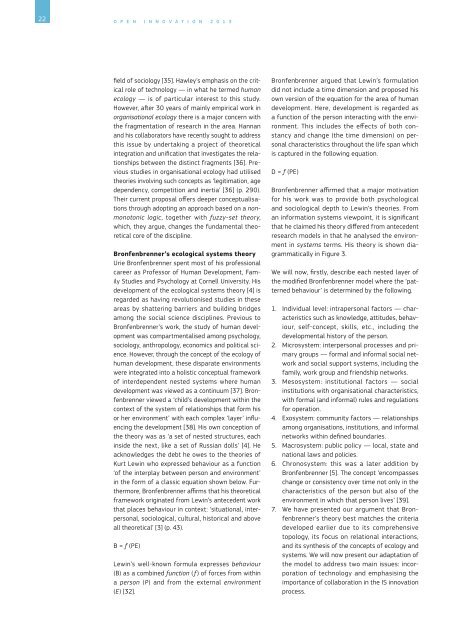Open Innovation 2.0 Yearbook 2013 - European Commission - Europa
Open Innovation 2.0 Yearbook 2013 - European Commission - Europa
Open Innovation 2.0 Yearbook 2013 - European Commission - Europa
You also want an ePaper? Increase the reach of your titles
YUMPU automatically turns print PDFs into web optimized ePapers that Google loves.
22 O P E N I N N O V A T I O N 2 0 1 3<br />
field of sociology [35]. Hawley’s emphasis on the critical<br />
role of technology — in what he termed human<br />
ecology — is of particular interest to this study.<br />
However, after 30 years of mainly empirical work in<br />
organisational ecology there is a major concern with<br />
the fragmentation of research in the area. Hannan<br />
and his collaborators have recently sought to address<br />
this issue by undertaking a project of theoretical<br />
integration and unification that investigates the relationships<br />
between the distinct fragments [36]. Previous<br />
studies in organisational ecology had utilised<br />
theories involving such concepts as ‘legitimation, age<br />
dependency, competition and inertia’ [36] (p. 290).<br />
Their current proposal offers deeper conceptualisations<br />
through adopting an approach based on a nonmonotonic<br />
logic, together with fuzzy-set theory,<br />
which, they argue, changes the fundamental theoretical<br />
core of the discipline.<br />
Bronfenbrenner’s ecological systems theory<br />
Urie Bronfenbrenner spent most of his professional<br />
career as Professor of Human Development, Family<br />
Studies and Psychology at Cornell University. His<br />
development of the ecological systems theory [4] is<br />
regarded as having revolutionised studies in these<br />
areas by shattering barriers and building bridges<br />
among the social science disciplines. Previous to<br />
Bronfenbrenner’s work, the study of human development<br />
was compartmentalised among psychology,<br />
sociology, anthropology, economics and political science.<br />
However, through the concept of the ecology of<br />
human development, these disparate environments<br />
were integrated into a holistic conceptual framework<br />
of interdependent nested systems where human<br />
development was viewed as a continuum [37]. Bronfenbrenner<br />
viewed a ‘child’s development within the<br />
context of the system of relationships that form his<br />
or her environment’ with each complex ‘layer’ influencing<br />
the development [38]. His own conception of<br />
the theory was as ‘a set of nested structures, each<br />
inside the next, like a set of Russian dolls’ [4]. He<br />
acknowledges the debt he owes to the theories of<br />
Kurt Lewin who expressed behaviour as a function<br />
‘of the interplay between person and environment’<br />
in the form of a classic equation shown below. Furthermore,<br />
Bronfenbrenner affirms that his theoretical<br />
framework originated from Lewin’s antecedent work<br />
that places behaviour in context: ‘situational, interpersonal,<br />
sociological, cultural, historical and above<br />
all theoretical’ [3] (p. 43).<br />
B = f (PE)<br />
Lewin’s well-known formula expresses behaviour<br />
(B) as a combined function (f) of forces from within<br />
a person (P) and from the external environment<br />
(E) [32].<br />
Bronfenbrenner argued that Lewin’s formulation<br />
did not include a time dimension and proposed his<br />
own version of the equation for the area of human<br />
development. Here, development is regarded as<br />
a function of the person interacting with the environment.<br />
This includes the effects of both constancy<br />
and change (the time dimension) on personal<br />
characteristics throughout the life span which<br />
is captured in the following equation.<br />
D = f (PE)<br />
Bronfenbrenner affirmed that a major motivation<br />
for his work was to provide both psychological<br />
and sociological depth to Lewin’s theories. From<br />
an information systems viewpoint, it is significant<br />
that he claimed his theory differed from antecedent<br />
research models in that he analysed the environment<br />
in systems terms. His theory is shown diagrammatically<br />
in Figure 3.<br />
We will now, firstly, describe each nested layer of<br />
the modified Bronfenbrenner model where the ‘patterned<br />
behaviour’ is determined by the following.<br />
1. Individual level: intrapersonal factors — characteristics<br />
such as knowledge, attitudes, behaviour,<br />
self-concept, skills, etc., including the<br />
developmental history of the person.<br />
2. Microsystem: interpersonal processes and primary<br />
groups — formal and informal social network<br />
and social support systems, including the<br />
family, work group and friendship networks.<br />
3. Mesosystem: institutional factors — social<br />
institutions with organisational characteristics,<br />
with formal (and informal) rules and regulations<br />
for operation.<br />
4. Exosystem: community factors — relationships<br />
among organisations, institutions, and informal<br />
networks within defined boundaries.<br />
5. Macrosystem: public policy — local, state and<br />
national laws and policies.<br />
6. Chronosystem: this was a later addition by<br />
Bronfenbrenner [5]. The concept ‘encompasses<br />
change or consistency over time not only in the<br />
characteristics of the person but also of the<br />
environment in which that person lives’ [39].<br />
7. We have presented our argument that Bronfenbrenner’s<br />
theory best matches the criteria<br />
developed earlier due to its comprehensive<br />
topology, its focus on relational interactions,<br />
and its synthesis of the concepts of ecology and<br />
systems. We will now present our adaptation of<br />
the model to address two main issues: incorporation<br />
of technology and emphasising the<br />
importance of collaboration in the IS innovation<br />
process.
















